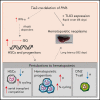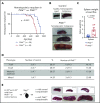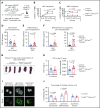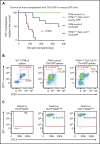PHF6 regulates hematopoietic stem and progenitor cells and its loss synergizes with expression of TLX3 to cause leukemia
- PMID: 30755422
- PMCID: PMC6695515
- DOI: 10.1182/blood-2018-07-860726
PHF6 regulates hematopoietic stem and progenitor cells and its loss synergizes with expression of TLX3 to cause leukemia
Abstract
Somatically acquired mutations in PHF6 (plant homeodomain finger 6) frequently occur in hematopoietic malignancies and often coincide with ectopic expression of TLX3. However, there is no functional evidence to demonstrate whether these mutations contribute to tumorigenesis. Similarly, the role of PHF6 in hematopoiesis is unknown. We report here that Phf6 deletion in mice resulted in a reduced number of hematopoietic stem cells (HSCs), an increased number of hematopoietic progenitor cells, and an increased proportion of cycling stem and progenitor cells. Loss of PHF6 caused increased and sustained hematopoietic reconstitution in serial transplantation experiments. Interferon-stimulated gene expression was upregulated in the absence of PHF6 in hematopoietic stem and progenitor cells. The numbers of hematopoietic progenitor cells and cycling hematopoietic stem and progenitor cells were restored to normal by combined loss of PHF6 and the interferon α and β receptor subunit 1. Ectopic expression of TLX3 alone caused partially penetrant leukemia. TLX3 expression and loss of PHF6 combined caused fully penetrant early-onset leukemia. Our data suggest that PHF6 is a hematopoietic tumor suppressor and is important for fine-tuning hematopoietic stem and progenitor cell homeostasis.
© 2019 by The American Society of Hematology.
Conflict of interest statement
Conflict-of-interest disclosure: The authors declare no competing financial interests.
Figures








Comment in
-
Context-specific tumor suppression by PHF6.Blood. 2019 Apr 18;133(16):1698-1700. doi: 10.1182/blood-2019-03-900829. Blood. 2019. PMID: 31000514 Free PMC article.
Similar articles
-
Plant homeodomain finger protein 6 in the regulation of normal and malignant hematopoiesis.Curr Opin Hematol. 2020 Jul;27(4):248-253. doi: 10.1097/MOH.0000000000000588. Curr Opin Hematol. 2020. PMID: 32398456 Review.
-
Phf6-null hematopoietic stem cells have enhanced self-renewal capacity and oncogenic potentials.Blood Adv. 2019 Aug 13;3(15):2355-2367. doi: 10.1182/bloodadvances.2019000391. Blood Adv. 2019. PMID: 31395598 Free PMC article.
-
The chromatin-binding protein Phf6 restricts the self-renewal of hematopoietic stem cells.Blood. 2019 Jun 6;133(23):2495-2506. doi: 10.1182/blood.2019000468. Epub 2019 Mar 27. Blood. 2019. PMID: 30917958
-
Phf6 Loss Enhances HSC Self-Renewal Driving Tumor Initiation and Leukemia Stem Cell Activity in T-ALL.Cancer Discov. 2019 Mar;9(3):436-451. doi: 10.1158/2159-8290.CD-18-1005. Epub 2018 Dec 19. Cancer Discov. 2019. PMID: 30567843 Free PMC article.
-
The Role of PHF6 in Hematopoiesis and Hematologic Malignancies.Stem Cell Rev Rep. 2023 Jan;19(1):67-75. doi: 10.1007/s12015-022-10447-4. Epub 2022 Aug 26. Stem Cell Rev Rep. 2023. PMID: 36008597 Review.
Cited by
-
PHF6 loss reduces leukemia stem cell activity in an acute myeloid leukemia mouse model.Cancer Cell Int. 2024 Feb 9;24(1):66. doi: 10.1186/s12935-024-03265-w. Cancer Cell Int. 2024. PMID: 38336746 Free PMC article.
-
PHF6 maintains acute myeloid leukemia via regulating NF-κB signaling pathway.Leukemia. 2023 Aug;37(8):1626-1637. doi: 10.1038/s41375-023-01953-6. Epub 2023 Jul 1. Leukemia. 2023. PMID: 37393343 Free PMC article.
-
Leukemia-mutated proteins PHF6 and PHIP form a chromatin complex that represses acute myeloid leukemia stemness.bioRxiv [Preprint]. 2024 Dec 18:2024.11.29.625909. doi: 10.1101/2024.11.29.625909. bioRxiv. 2024. Update in: Genes Dev. 2025 Jul 28. doi: 10.1101/gad.352602.125. PMID: 39677666 Free PMC article. Updated. Preprint.
-
Transgenic mice with an R342X mutation in Phf6 display clinical features of Börjeson-Forssman-Lehmann Syndrome.Hum Mol Genet. 2021 May 12;30(7):575-594. doi: 10.1093/hmg/ddab081. Hum Mol Genet. 2021. PMID: 33772537 Free PMC article.
-
Epigenetic reversal of hematopoietic stem cell aging in Phf6-knockout mice.Nat Aging. 2022 Nov;2(11):1008-1023. doi: 10.1038/s43587-022-00304-x. Epub 2022 Nov 10. Nat Aging. 2022. PMID: 37118089 Free PMC article.
References
-
- Li X, Yao H, Chen Z, Wang Q, Zhao Y, Chen S. Somatic mutations of PHF6 in patients with chronic myeloid leukemia in blast crisis. Leuk Lymphoma. 2013;54(3):671-672. - PubMed
-
- Xiao W, Pastore F, Getta B, et al. . PHF6 mutations defines a subgroup of mixed phenotype of acute leukemia with aberrant T-cell differentiation [abstract]. Blood. 2017;130(suppl 1). Abstract 1384.
Publication types
MeSH terms
Substances
LinkOut - more resources
Full Text Sources
Medical
Molecular Biology Databases
Research Materials

